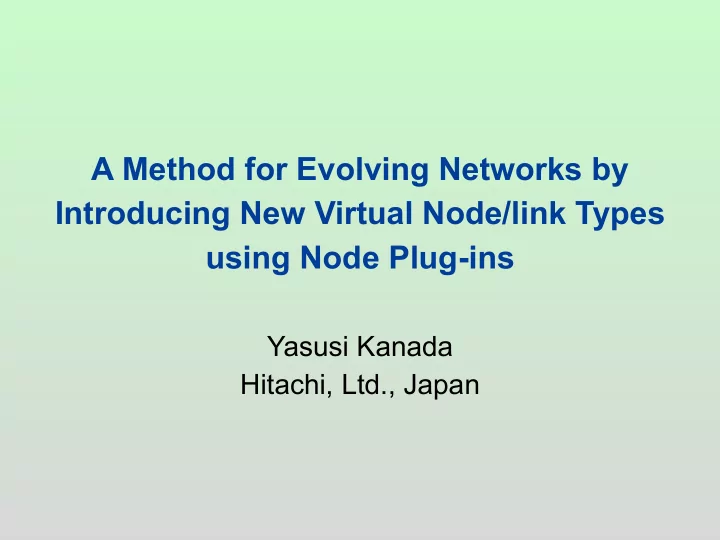

A Method for Evolving Networks by Introducing New Virtual Node/link Types using Node Plug-ins Yasusi Kanada Hitachi, Ltd., Japan
Introduction ► Virtual networks (or slices) are suited for development of new services. ■ Service providers develop new services as slice developers . ► New services may be supported by evolution of nodes with network-virtualization functions, i.e., “VNodes”. ■ VNodes mean physical network nodes (not virtual nodes). ■ New services requires new virtual-network functions, which may be supported by evolution of node software or hardware. ► Two-stage evolution method for VNodes is proposed. ■ [1st stage] VNodes are evolved by adding and updating plug-ins without modifying original components (previous paper). ■ [2nd stage] Plug-ins are integrated into VNode (focus of this paper). ■ This method was developed for our VNodes , but it is a generic method. SDNMO 2014 2014-5-9 Yasusi Kanada, Hitachi, CRL 2
Our VNode and its Components ► A type of VNode was developed by a collaborative project conducted by Professor Aki Nakao (U. Tokyo). ► This VNode consists of modular components: ■ Programmer : a deeply-programmable computational component. ■ Redirector : a networking component. VNode Programmer VNode Manager Redirector SDNMO 2014 2014-5-9 Yasusi Kanada, Hitachi, CRL 3
Evolution of VNode ► VNode components may evolve by using new node hardware or software , or new functions . ■ New hardware/software : New network processors, GPGPUs, New types of VMs, etc. ■ New functions : New protocol stacks, etc. ► VNode components can evolve independently because they are modular . VNode Evolved VNode Evolution Programmer New Programmer VNode VNode Independent Manager Manager Redirector New Redirector Evolution SDNMO 2014 2014-5-9 Yasusi Kanada, Hitachi, CRL 4
Proposed Method: Two-stage Evolution of VNode ► Experimental stage: Operators/vendors develop new subcomponents as plug-ins w/o updating VNode. ► Operational stage: Operators/vendors merge the plug- ins into VNode and developers use the new functions. Experimental stage Operational stage Original VNode Evolving VNode Evolved VNode New VNM VNM VNM Redirector Redirector Redirector Redirector Redirector Redirector Redirector Redirector plug-ins Redirector plug-ins component component component component Original Original New Original+new resources resources resources resources Programmer Programmer Programmer Programmer Programmer Programmer Programmer plug-ins plug-ins Programmer component component Programmer VNode VNode VNode in a extensions New VNode in a public testbed public testbed Extended VNode SDNMO 2014 2014-5-9 Yasusi Kanada, Hitachi, CRL 5
Experimental Stage: Plug-in Architecture ► A data plug-in handles data packets. ■ It consists of hardware and software. ► The data plug-in is controlled by a control plug-in. ■ New control functions required for the data plug-in is implemented by the control plug-in (which is assumed to be distributed). ► Plug-ins are connected to a VNode. Extended VNode VNode Plug-ins Control plug-in interface Control-plane Control plug-in component C-plane D-plane Data-plane Data plug-in component (Packet handling Data plug-in (L3 switch) plug-in) interface SDNMO 2014 2014-5-9 Yasusi Kanada, Hitachi, CRL 6
Experimental Stage: Virtual-node/link Spec ► A developer specifies a new type of virtual-node/link with parameters that specify plug-in parameters. <linkSliver type="link" …> <vports> <vport name="vport1"> A virtual link <params> <param key="ControlPort" value="CPIl1-addr"/> specification <param key="DataPort" value="DPIl1-port"/> </params> (RSpec): </vport> <vport name="vport2"> <params> <param key="ControlPort" value="CPIl2-addr"/> <param key="DataPort" value="DPIl2-port"/> </params> </vport> </vports> <params> <param key="PlugInName" value="virtual-link-1"/> <param key="Command-reserveLinkSliver1" value="ls_setup_1"/> So many <param key="Command-reserveLinkSliver2" value="ls_setup_2"/> <param key="Command-reserveLinkSliver3" implementation- value="ls_setup_3"/> <param key="Command-runSliver" dependent parameters value="ls_run"/> <param key="Command-shutdownSliver" must be specified! value="ls_stop"/> </params> </linkSliver> ► VNode control components tunnels these parameters. ■ They do not check everything in specifications. SDNMO 2014 2014-5-9 Yasusi Kanada, Hitachi, CRL 7
Operational Stage: Requirements ► Plug-in functions must be merged into the VNode. ► Requirements for operators and vendors ■ Newly added modules (types) must be authenticated and authorized. • Plug-ins may contain “viruses”, which must be avoided in operational stage. ■ The implementation cost must be minimized. • To merge new functions to the original modules (i.e., tightly- coupled modules) may be too costly. ► Requirement for developers ■ New virtual-node/link types must be available in the same method (by the same simple syntax) as built-in types. SDNMO 2014 2014-5-9 Yasusi Kanada, Hitachi, CRL 8
Operational Stage: Loosely-coupled Architecture ► To reduce the cost, plug-ins are not modified. ■ The data plug-in is still managed by the control plug-in. ► Plug-in information is entered into the VNode and the network manager (in plug-in parameter mapping tables) . Keys Control plug-in Data plug-in node-type-1 Control plug-in identifier, Authorization Data plug-in identifier, information, Commands Authentication information VNode0 CPIn0-addr DPIn0-port VNode1 CPIn1-addr DPIn1-port VNode2 CPIn2-addr DPIn2-port There are parameters to be link-type-1 Control plug-in identifier , Authorization Data plug-in identifier, information, Commands Authentication information distributed and VNode0 CPIl0-addr DPIl0-port centralized ► Plug-ins are authorized by the operator. VNode1 CPIl1-addr DPIl1-port ■ The mapping table contains authorized plug-ins only. VNode2 CPIl2-addr DPIl2-port ► Plug-ins are authenticated by the VNode. ■ The operator registers the authentication information. SDNMO 2014 2014-5-9 Yasusi Kanada, Hitachi, CRL 9
Operational Stage: Virtual-node/link Spec ► Slice developers can specify a new virtual-node/link type using the same simple syntax as built-in types. ■ Plug-in parameters are supplied by VNode control components by using the mapping table. A virtual link <linkSliver type="link" subtype=" link-type-1 "> <vports> specification <vport name="vport1"/> (RSpec): <vport name="vport2"/> </vports> Used for // No plug-in parameters accessing the </linkSliver> mapping table SDNMO 2014 2014-5-9 Yasusi Kanada, Hitachi, CRL 10
Recommend
More recommend